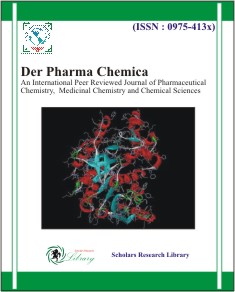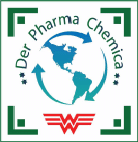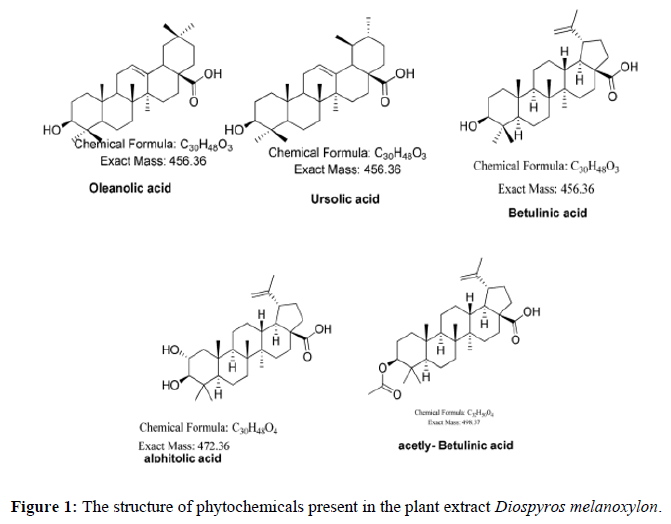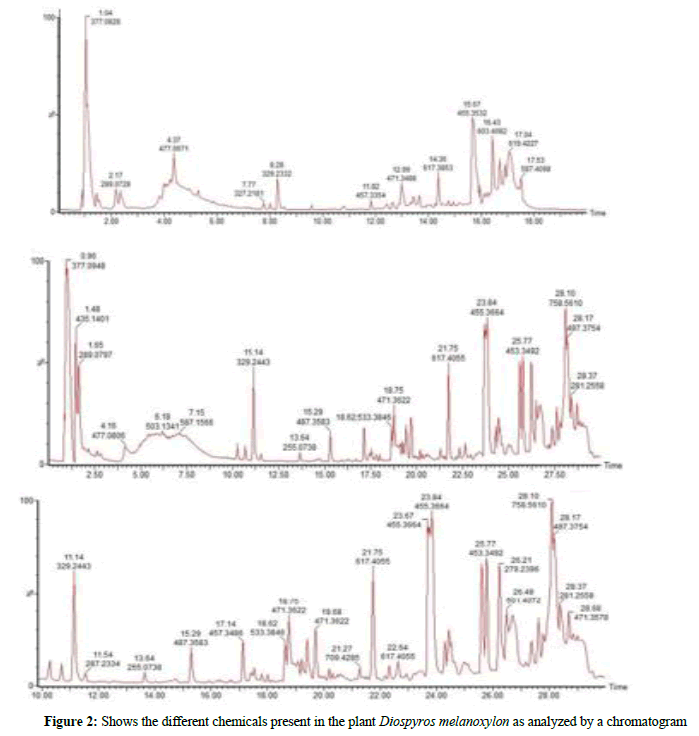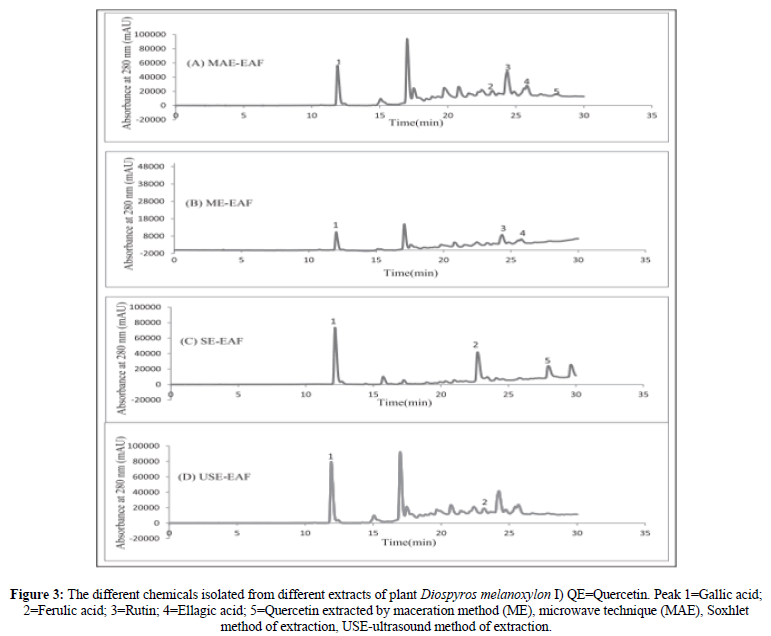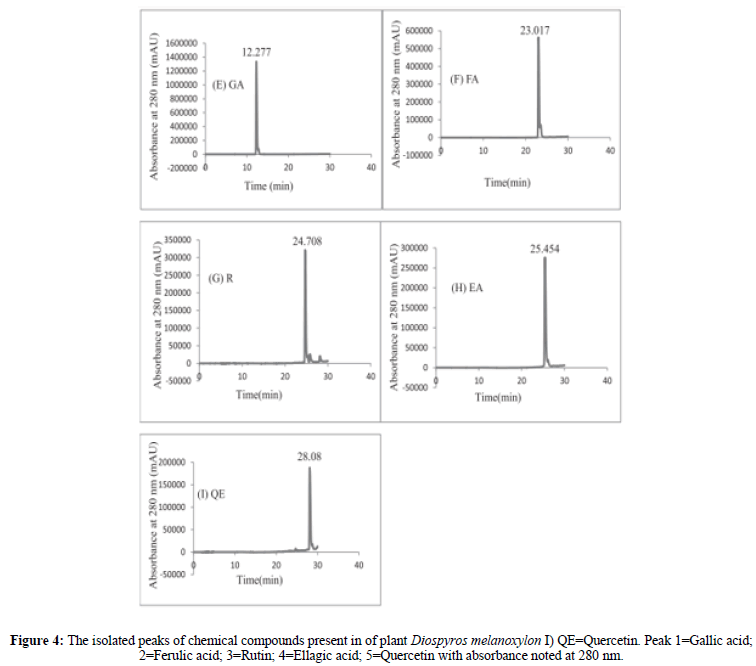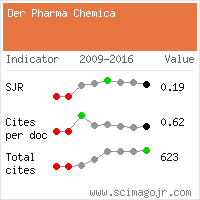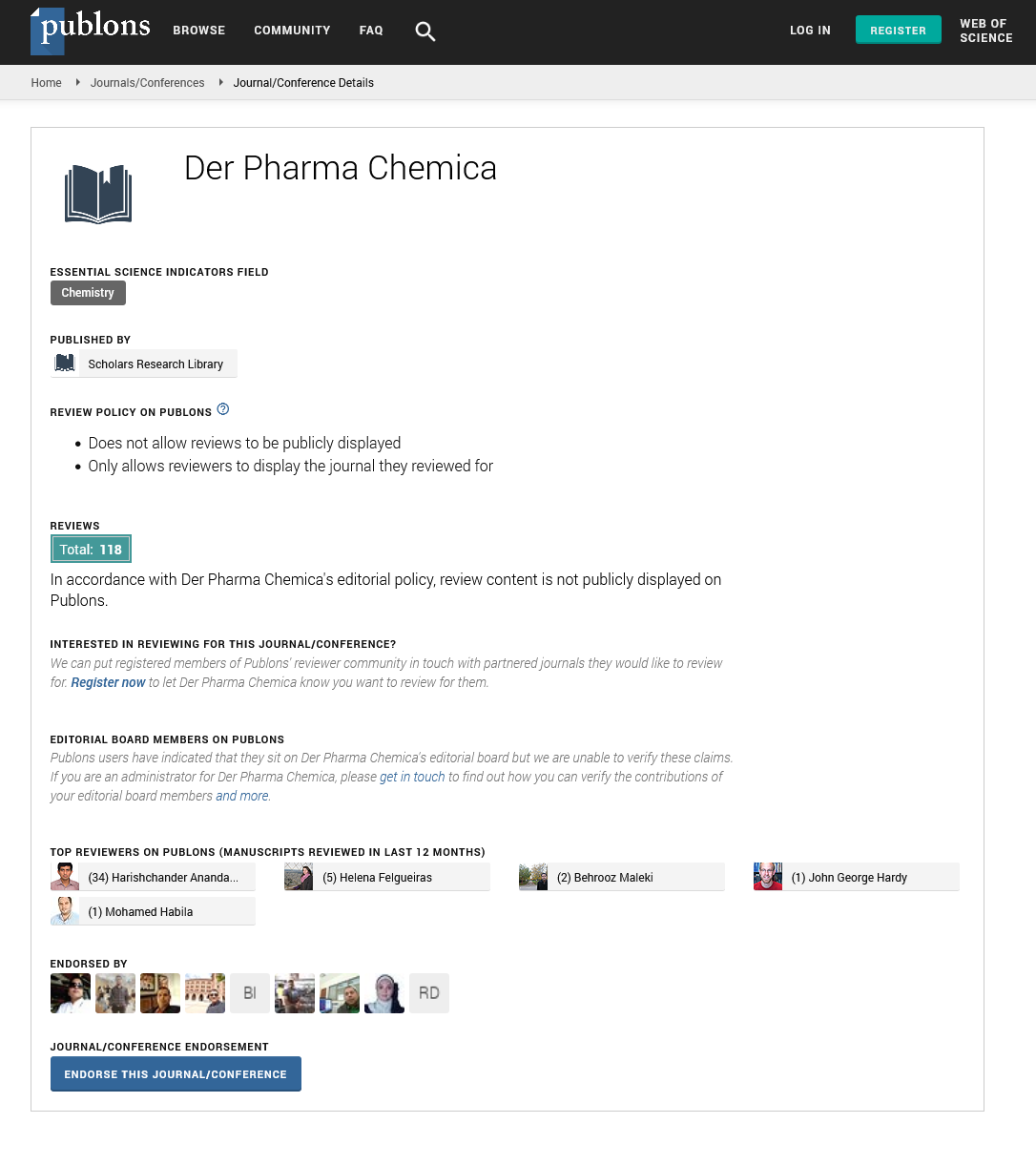Research Article - Der Pharma Chemica ( 2025) Volume 17, Issue 1
Phytochemical Investigation of Diospyros melanoxylon Medicinal Plants
S. K. Patil* and U. B. ChanshettibS. K. Patil, Department of Pharmacy, Yashwantrao Chavan College of Science, Karad, India, Email: shankarkpatil.2013@gmail.com
Received: 28-Oct-2024, Manuscript No. DPC-24-155698; Editor assigned: 31-Oct-2024, Pre QC No. DPC-24-155698 (PQ); Reviewed: 14-Nov-2024, QC No. DPC-24-155698; Revised: 01-Feb-2025, Manuscript No. DPC-24-155698 (R); Published: 28-Feb-2025, DOI: 10.4172/0975-413X.17.1.592-600
Abstract
The leaves of Diospyros melanoxylon were studied and found to have many medicinal chemicals in them. These include terpenoids, flavonoids, phenolic compounds, alkaloids, tannins and saponins. Researchers used modern tools like LC-Q-TOF-MS and NMR spectroscopy to find important parts of the plant. These parts included fatty acids like hydroxylenoliate and linoleate, as well as gallic acid, ellagic acid, quercetin, oleanolic acid and betulinic acid. There were different amounts of these chemicals found and the holding times ranged from 1.07 to 27.62 minutes. The study also found that the mass accuracy was very good, with measurement mistakes usually being less than 1 ppm. This shows that the plant may be good for your health because it has vitamins, anti-inflammatory qualities and other good substances. Phytochemical tests proved the presence of important primary and secondary molecules, which added to the plant's medical and nutritional value.
Keywords
Diospyros melanoxylon; Phytochemicals; Medicinal value
Introduction
Diospyros melanoxylon is mostly found in dry deciduous woods; however, it may also flourish in evergreen forests contingent upon local circumstances. It exhibits extensive distribution across India, extending from the Indian peninsula to the sub-Himalayan areas of Nepal, as well as the Indian lowlands, including the Gangetic plain, Madhya Pradesh, Maharashtra and the Western coast up to Malabar [1]. This tree may thrive in impoverished, arid soils, on hot, dry slopes and in rocky soils composed of quartzite, shale, sandstone and dense clays. In dry places, the tree temporarily abscises its leaves during the hot season but regenerates them in May-June. Conversely, in more humid regions, the tree remains evergreen [2].
Morphology: Diospyros melanoxylon is a moderately big tree. The bark is pelican-hued and exfoliates in rectangular scales, a distinctive trait of the tree. The main root is first elongated, robust and succulent, thereafter transforming into a woody and grayish structure, often exhibiting swelling at the higher portion near the soil surface. The leaves are elliptical or oblong, placed alternately or oppositely and possess a leathery feel. They may attain a length of up to 36 cm, first exhibiting a velvety texture on both sides during their youth and thereafter becoming smooth on the top side as they grow. The male flowers are mauve, usually possessing four to six petals and are sessile or almost sessile on short peduncles, frequently arranged in clusters of three. The female blooms are mauve, mostly extra-axillary or infrequently solitary, often occurring in pairs facing one another. These blooms are more substantial than the male blossoms. The fruit of the tree is olive-green, ovoid or globular, about 3 cm-4 cm in diameter and may contain one or several seeds. The pulp is golden, tender and saccharine. The seeds are compressed, elongated, lustrous and often striped. The tree flowers in April-May and produces fruit from March to April [3].
Distribution and habitat: Diospyros melanoxylon is typically found in dry deciduous forests, though it can also grow in evergreen forests depending on its surroundings. It has a widespread distribution throughout India, covering the entire Indian peninsula and extending up to Nepal in the sub-Himalayan regions. It is also found across the Indian plains, the Gangetic plain, Madhya Pradesh, Maharashtra and the Western coast up to Malabar. This tree is capable of growing on poor, barren soils, dry and rocky hill slopes and soils containing quartzite, shale, sandstone and heavy clay. In dry areas, it sheds its leaves for a short time during hot weather, but it regains them in May-June. In wetter areas, it remains evergreen.
Ethnomedicinal uses: The leaves of Diospyros melanoxylon are used for their diuretic, carminative, laxative and styptic properties. The dried flowers are helpful in treating urinary problems, leucorrhoea, anemia, skin infections and blood-related disorders. The fruits have a cooling and astringent effect and are used to treat stomach issues [4]. The bark is astringent and its decoction is used to treat diarrhoea and indigestion [5]. The seeds are believed to be effective in treating mental health issues, nervous system disorders and heart palpitations.
Food value: The ripe fruits of Diospyros melanoxylon are tasty and edible (present study). The fruits are also offered as offerings to deities in tribal rituals. Additionally, the powdered fruits and seeds are consumed and sold in local markets.
Morphology: Diospyros melanoxylon is a medium-sized tree. Its bark is pelican-colored and peels off in rectangular scales, which serves as an identifying feature. The primary root is initially long, thick and fleshy, but it later becomes woody and greyish, often swollen near the ground. The leaves are elliptical or oblong in shape and they can be arranged alternately or oppositely. They are leathery and can grow up to 36 cm in length. When young, the leaves are velvety on both sides, but they become smooth on the upper surface as they mature. The male flowers are mauve in color, typically having four to six petals and are sessile or nearly sessile on short peduncles, usually appearing in clusters of three. The female flowers are also mauve, generally extra-axillary or sometimes solitary and are usually paired oppositely. These flowers are larger than the male flowers. The fruit of the tree is olive-green, either ovoid or globular in shape, measuring 3 cm-4 cm across. It may contain one or multiple seeds. The pulp is yellow, soft and sweet and the seeds are compressed, oblong, shiny and often banded. The tree blooms in April-May and fruits from March to April.
The leaves of Diospyros melanoxylon possess diuretic, carminative, laxative and styptic effects. Dried flowers are beneficial for addressing urinary problems, leucorrhoea, anemia, skin infections and blood diseases. The fruits possess a cooling and astringent impact, making them advantageous for digestive issues. The bark has astringent characteristics and its decoction is often used to mitigate diarrhoea and indigestion. The seeds are used to address mental health issues, nervous system disruptions and cardiac palpitations. The mature fruits of Diospyros melanoxylon are palatable and consumable. These fruits are often presented to deities during tribal rituals. The powdered variant of the fruits and seeds is used and marketed in local marketplaces.
The leaf extract of Diospyros melanoxylon has several advantageous substances, such as carbohydrates, lipids, oils, steroids, glycosides, tannins, flavonoids and saponins [6]. A preliminary phytochemical investigation identified steroids and triterpenoids in the petroleum ether extract, along with flavonoids, tannins, phenolic compounds, sterols and triterpenoids in the ethyl acetate extract [7]. The alcoholic extract comprises flavonoids, tannins, phenolic compounds and steroids, while the aqueous extract includes carbohydrates, proteins, amino acids, flavonoids, tannins and tartaric acid [8]. Numerous bioactive triterpenoids have shown diverse biological actions, especially in enhancing glucose absorption, glucose uptake, insulin secretion and mitigating diabetes-related problems such as vascular dysfunction, retinopathy and nephropathy. Steroids in the plant may enhance insulin secretion by encouraging the regeneration of residual cells. Diospyros melanoxylon has been used in the management of several ailments, such as diabetes, anemia, splenic inflammation, dyspepsia, diarrhoea, scabies and as a diuretic and laxative [9].
The edible fruits of Diospyros melanoxylon have ecological and economic significance, since they are devoured and disseminated by fruit bats and avian species, particularly hornbills. This plant offers a diverse array of goods, including food, fodder, fuel, lumber and medicinal resources. Ripe fruits are marketed in rural areas and along highways. The foliage of Diospyros melanoxylon is esteemed for its use as wraps for bidis (traditional rural cigarettes). The leaves are valued for their taste, versatility and durability, making them suitable for this use. Recently developed shoots are collected to provide premium wrapper leaves. The timber of the tree is dense, pale pink, resilient and robust, making it appropriate for construction materials, shoulder poles, mining supports and carriage shafts. Ebony wood is thick and highly valued for carving and decorative applications (Figure 1) [10].
Figure 1. The structure of phytochemicals present in the plant extract Diospyros melanoxylon.
This plant is rich in phytochemicals, featuring complex organic molecules such as lupeol, betulin, betulinic acid, ursolic acid and two types of amyrin. These compounds are not just passive ingredients; they hold the potential to unlock secrets about biological functions. The presence of sterols like β-Sitosterol and Sigmasterol adds further depth to the plant's chemical makeup. These molecules act similarly to cholesterol found in animal cells, playing vital roles in maintaining cellular integrity and supporting various biological processes. The main phytochemicals identified in different parts of the plant include:
Flavonoids: These are important antioxidants that help in reducing oxidative stress and may have anti-inflammatory and anticancer properties.
Tannins: Found in the leaves and bark, tannins have antimicrobial and astringent properties. They are also believed to aid in wound healing and act as antioxidants.
Alkaloids: Alkaloids, present in the roots and bark, may have analgesic and antipyretic effects, helping in reducing pain and fever.
Saponins: Saponins have been known for their anti-inflammatory and immunomodulatory effects and they also possess antimicrobial properties.
Phenolic acids: Phenolic compounds, such as gallic acid, are present in the plant and contribute to its antioxidant activity. These compounds may also help in regulating blood sugar levels.
Triterpenoids: Triterpenes, found in the leaves and bark, are known for their anti-inflammatory, antidiabetic and anticancer activities.
Steroids: The plant contains sterols, which can have cholesterol-lowering effects and contribute to its overall health benefits.
Essential oils: The leaves of Diospyros melanoxylon contain essential oils, which may have antimicrobial and antifungal effects.
Materials and Methods
Experimental
Extraction and isolation of chemical constituents from the plants: Modern scientific research requires advanced techniques in extracting and isolating different compounds from plant material. In this comprehensive research, scientists adopted several extraction techniques to improve the isolation and characterization of these compounds. This method mainly consisted of the old technique called the Soxhlet extraction. This researcher prepared and extracted 20 grams of fine powder ground plant material, by processing in a specific and very controlled way, using specialized apparatus. The solvent utilized was hydro-methanolic with continuous extraction for the extended period of 25 hours. Subsequently, this extracted material is filtered and then carefully evaporated to retain concentrated botanical extracts for further investigation.
The study concentrated on the leaves of Diospyros melanoxylon (D. melanoxylon) from India. The leaves were gathered. The researchers conducted first phytochemical screening using standardized methodologies. They analyzed the leaf extracts for many compounds:
Phenolics: Leaves were subjected to boiling in water and then combined with ferric chloride. A green or blue hue indicated the presence of phenolics.
Flavonoids: Leaves were macerated in water and then combined with ethyl acetate. The presence of flavonoids was indicated by a yellow hue.
Terpenoids: The leaves were combined with ethanol, chloroform and sulfuric acid. A reddish-brown precipitate near the contact indicated the presence of terpenoids.
Alkaloids: The leaves were solubilized in hydrochloric acid and then analyzed using specified reagents. Precipitates indicated the presence of alkaloids.
Tannins: Leaves were pulverized in water and combined with ferric chloride. A blue hue change indicated the presence of tannins.
Saponins: The leaves were macerated in water and agitated. The presence of saponins was shown by honeycomb foam after 30 minutes. They created standard solutions of lupeol, betulinic acid, oleanolic acid and ursolic acid in methanol at different concentrations for the analysis. The leaf samples were dried, crushed into powder and extracted using methanol. The extract was concentrated and readied for examination. Sophisticated Liquid Chromatography-Mass Spectrometry (LC-MS) equipment was used to assess the phytochemicals. The study used a designated column, gradient elution and mass spectrometric measurements to identify and describe the chemicals in the leaf extract. The methodology used meticulous scientific methods to analyze and identify the chemical components in D. melanoxylon leaves.
Results and Discussion
The researchers performed a qualitative examination of phytochemicals in the leaf extract of Diospyros melanoxylon. They discovered disparate concentrations of several chemicals. Terpenoids and flavonoids were prominently prevalent. Phenols and alkaloids were prominently prevalent. Saponins and tannins were identified, but at reduced amounts.
Comprehensive compound examination: The researchers detected several beneficial chemicals in the leaf extract using sophisticated Liquid Chromatography-Mass Spectrometry (LC-Q-TOF-MS). A number of notable chemicals were identified:
Organic acids and phenolic compounds: The study identified many organic acids and phenolic substances, including:
• Gallic acid
• Ellagic acid
• Quercetin P-coumaroyltriacetate
Fatty acids and their derivatives: A variety of fatty acids and their derivatives were found, including: 9S,12R,13S-Trihydroxy-10E,15-zoctadecadienoic acid 9,10,18-trihydroxystearate 9,12,13-trihydroxyoctadecenoate 9,10-Dihydroxystearate Hydroxylenoliate Linoleate (Figure 2).
Triterpenoids and complex compounds: The researchers furthermore identified several triterpenoids and intricate molecular structures:
• Holothurinogenin
• Oleanolic acid
• Ursolic acid
• Betulinic acid
• Numerous acylated triterpenoids.
Figure 2. Shows the different chemicals present in the plant Diospyros melanoxylon as analyzed by a chromatogram.
Certain chemicals were distinctive or not completely characterized, designated as "unknown" in the study. The molecular structures exhibited significant variation in molecular weights, formulae and fragmentation patterns. The Retention periods (Rt) of these compounds varied from 1.07 to 27.62 minutes. This thorough research elucidates the complex chemical makeup of Diospyros melanoxylon leaves, emphasizing the potential therapeutic and biological importance of these substances. Several interesting findings arise from the LC-Q-TOF-MS investigation of bioactive chemicals in D. melanoxylon's methanolic leaf extract. The findings indicate outstanding accuracy in mass detection, with most compounds having a remarkable match between observed and predicted masses. The error margins, measured in Parts Per Million (ppm), are particularly modest, ranging from -2.7 ppm to 9.5 ppm, with gallic acid exhibiting the greatest departure at 9.5 ppm, while many other substances show errors below 1 ppm. The retention time profile ranges from 1.07 to 27.62 minutes, with simpler compounds like gallic acid eluting first and more complex structures like betulinic acid and fatty acids following later in the chromatographic run. The analysis identified several major classes of compounds, including phenolic compounds (represented by Gallic acid and ellagic acid), flavonoids (such as Quercetin), triterpenes (including oleanolic acid, ursolic acid and betulinic acid), fatty acids and their derivatives and acylated triterpenoids. The identified compounds' masses vary from relatively tiny molecules like gallic acid (169.0153 m/z) to much bigger compounds with masses of up to 709.4019 m/z. This thorough study indicates the rich diversity of bioactive chemicals found in D. melanoxylon leaves, with good mass accuracy and a wide retention time range implying accurate compound identification and separation.
NMR spectra results of chemicals present in the plant Diospyros melanoxylon: Chemical analysis of Diospyros melanoxylon revealed a vast number of compounds belonging to several chemical classes, including fatty acids, tetracyclic triterpenoids, pentacyclic triterpenoids and phenolic compounds. Three significant compounds were isolated as triterpenoids with almost the same molecular weights. The retention time of betulinic acid was observed at 24.44 minutes with a molecular mass of m/z 455.3526[M-H]-. Oleanolic acid emerged next at 23.70 minutes with a molecular mass of m/z 455.3532[M-H]- and Ursolic acid emerged at 23.82 minutes with a molecular mass of m/z 455.352[M-H]-. Such triterpenoids display strong structural resemblance. Also, the scientists isolated some derivatives of betulinic acid in the leaves of the plant, which were unique and characterized by specific structural features, such as conjugations of hydroxycinnamic acid. This discovery underlines the complex chemical nature of Diospyros melanoxylon. In the domain of phenolic compounds, several significant molecules were found, such as Gallic acid, which presented with a molecular mass of m/z 169.0153 and seemed to be a simple phenolic acid and Ellagic acid, which presented with a molecular mass of m/z 300.9980 and seemed to be a more complex polyphenolic structure.
Flavonoids: There were two significant compounds identified within the flavonoid group. Quercetin was identified with a molecular mass of m/z 301.0346, known for its numerous health benefits, while Rutin was also detected, completing the profile of phenolic compounds present in the plant. Each of these compounds contributes to the understanding of the plant's intricate chemical composition, revealing a rich variety of molecular structures that range from simple acids to complex triterpenoid derivatives. The identification of these compounds accurate enough provides insight into the potential medicinal and biological properties of Diospyros melanoxylon (Table 1).
| Phytochemical | Test | Result (presence/absence) |
|---|---|---|
| Sterols | Liebermann-Burchard test | + |
| Salkowski test | + | |
| Triterpenoids | Liebermann-Burchard test | + |
| Salkowski test | + | |
| Glycosides | Keller-Kiliani test | + |
| Borntrager’s test | - | |
| Saponins | Foam test | + |
| Hemolysis test | + | |
| Carbohydrates | Benedict’s test | + |
| Molisch test | + | |
| Alkaloids | Dragendorff’s test | + |
| Mayer’s test | + | |
| Flavonoids | Shinoda test | + |
| Alkaline Reagent test | + | |
| Tannins | Ferric Chloride test | + |
| Gelatin test | + | |
| Phenolic compounds | Ferric chloride test | + |
| Proteins | Biuret test | + |
| Xanthoproteic test | + | |
| Amino acids | Ninhydrin test | + |
| Fats and oils | Spot test | + |
| Saponification test | + |
Table 1: The absence or presence of chemicals in Diospyros melanoxylon.
Phytochemical study results, showing that Diospyros melanoxylon has a wide range of beneficial chemicals. So, this means that the plant has a lot of promise for use in medicine and pharmacology. The data for each type of phytochemical will be talked about in the parts that follow. Liebermann-Burchard and Salkowski tests for sterols and triterpenoids were positive, meaning they are present in the plant. These substances are known to have health benefits, such as anti-inflammatory properties, protection of the liver and lowering cholesterol. This makes the plant much more important for medicine. The Keller-Kiliani test also showed the presence of cardiac glycosides, which are important for healing problems with the heart. But Borntrager's test returned negative, thus anthraquinone glycosides are absent. This explains the types of glycosides that are present in Diospyros melanoxylon. The positive results in the foam and hemolysis tests indicate that saponins exist. These compounds are highly known for their numerous health benefits, including the killing of bacteria and fungi, besides enhancing the immune system. In addition, saponins have the capability to lower the surface tension, making them beneficial in the design of drug delivery systems. Carbohydrates are positively identified by the positive Benedict's and Molisch test outcomes. These are essential metabolites that provide a significant part of the energy in a plant and are, thus, an important aspect of nutritional quality. Positive Dragendorff's and Mayer's test results indicate the presence of alkaloids. These substances have been used for various treatments that have included analgesia, anti-malarial activity and even antibacterial activity. Flavonoids were proved to exist by the Shinoda and alkaline reagent tests. These antioxidants are powerful and will play a crucial role in combating oxidative stress, reducing inflammation and preventing chronic diseases. The research with ferric chloride and gelatin established the fact that tannins are there. These compounds, which fall within the polyphenolic family, have been found to kill germs, firm up the skin and promote healing of wounds. This makes them of extreme importance in traditional medicine. A positive ferric chloride test also implies the presence of phenolic compounds, which are known to have a protective effect as well as to remove free radicals. These chemicals play a vital role in maintaining your health in good shape since they reduce the damage that reactive stress does. Tests for proteins with Biuret and Xanthoproteic test and for amino acids using Ninhydrin were all positive, thus confirming the presence of these vital structures. Along with being good for your health, proteins and amino acids may also promote tissue repair and assist enzymes to perform their functions. The spot and saponification tests determined the presence of fats and oils. These are important because they can provide energy and perhaps make the plant more peaceful and healing. The different substances found in Diospyros melanoxylon suggest that it can be used in many different ways in medicine. The discovery of secondary metabolites such as alkaloids, flavonoids, tannins and phenolic chemicals shows promise that the plant has a lot to offer as a medicine, especially on the antibiotic, anti-inflammatory and antioxidant benefits. Nutritionally, the plant is beneficial because it contains proteins, carbs and fats (Tables 2 and 3) (Figures 3 and 4).
| Phytochemical | Test name | Procedure | Positive observation |
|---|---|---|---|
| Sterols | Liebermann-Burchard test | Add acetic anhydride and concentrated H2SO4 to the extract | Formation of a green or bluish-green color |
| Salkowski test | Add chloroform and concentrated H2SO4 | Red or reddish-brown color at the interface | |
| Triterpenoids | Liebermann-Burchard test | Add acetic anhydride and concentrated H2SO4 to the extract | Formation of a red to pink coloration |
| Salkowski test | Add chloroform and concentrated H2SO4 | Golden yellow coloration | |
| Glycosides | Keller-Kiliani test | Add glacial acetic acid, FeCl3 solution and concentrated H2SO4 | Reddish-brown ring at the interface |
| Legal’s test | Treat with sodium nitroprusside and NaOH | Formation of a pink to red color | |
| Saponins | Foam test | Shake the aqueous extract vigorously | Formation of stable, persistent froth |
| Carbohydrates | Benedict’s test | Heat with Benedict’s reagent | Formation of red or brick-red precipitate |
| Molisch test | Add α-naphthol followed by concentrated H2SO4 along the sides of the test tube | Formation of a violet ring at the interface | |
| Alkaloids | Dragendorff’s test | Treat with Dragendorff’s reagent (potassium bismuth iodide solution) | Orange or reddish-brown precipitate |
| Mayer’s test | Add Mayer’s reagent (mercuric potassium iodide solution) | Formation of a white or creamy precipitate | |
| Flavonoids | Alkaline reagent test | Treat with NaOH | Yellow coloration, which disappears on acid addition |
| Shinoda test | Add magnesium ribbon and concentrated HCl | Pink or red coloration | |
| Tannins | Ferric chloride test | Treat with FeCl3 solution | Formation of blue-black or green-black color |
| Phenolic compounds | Ferric chloride test | Add FeCl3 solution to the extract | Blue or green coloration |
| Proteins | Biuret test | Add NaOH and CuSO4 solution | Formation of violet or purple color |
| Xanthoproteic test | Add concentrated HNO3 and heat; then add NH3 solution | Yellow color turning orange with NH3 | |
| Amino acids | Ninhydrin test | Heat the extract with ninhydrin solution | Formation of purple or blue color |
| Fats and oils | Spot test | Press the extract on filter paper | Formation of a permanent translucent spot |
| Saponification test | Heat with NaOH and observe soap formation | Formation of soap and foam |
Table 2: The different methods of phytochemical screening of chemical metabolites.
Figure 3. The different chemicals isolated from different extracts of plant Diospyros melanoxylon I) QE=Quercetin. Peak 1=Gallic acid; 2=Ferulic acid; 3=Rutin; 4=Ellagic acid; 5=Quercetin extracted by maceration method (ME), microwave technique (MAE), Soxhlet method of extraction, USE-ultrasound method of extraction.
| Assay | IC50 (μg extract/ml) | Plant extract | Standard |
|---|---|---|---|
| DPPH radical scavenging | IC50 | 62.45 ± 2.15 | 20.7 ± 0.8 |
| ABTS radical scavenging | IC50 | 78.32 ± 3.27 | 18.5 ± 0.9 |
Table 3: DPPH and ABTS analysis in the plant extract of Diospyros melanoxylon.
Result: The results indicate that Diospyros melanoxylon kills germs quite well, especially Staphylococcus aureus and Pseudomonas aeruginosa. Therefore, this might be the best source of ideas to prepare antibacterial drugs. It still needs more study because it is ineffective against fungi and is not as good as normal antibiotics. They may attempt to purify the active chemicals, study their interaction with normal antibiotics and determine whether they possess antibacterial properties in the future.
Presence of different metabolites in Diospyros melanoxylon: The sample under investigation reveals an interesting diversity of complex organic compounds, each having different molecular structures and remarkable pharmacological properties. Piceatannol 3-O-glucoside leads the group, accounting for 24.11% of the sample and is identified early on for its strong antioxidant properties that protect cellular systems from oxidative stress. Next in line is Carnosic acid, which represents 15.39% of the sample and appearing at 4.421 min, with an impressive capacity to act both as antioxidant and antimicrobial agent with a potential ability to avoid cell damage and inhibit bacteria growth. Vanillic acid and Catechin-3-O gallate significantly contribute to the sample also, representing 13.83% and 13.67% respectively; they provide antioxidant and antibacterial effects, complementally. These compounds combine to scavenge free radicals and may contribute to inhibition of bacterial growth. Myristicin at 5.381 minutes, constituting 11.96%, further strengthens the composition of the extract with its reported antioxidant and antimicrobial characteristics. The remaining compounds include Citronellol at 6.70% and Capsidiol at 5.70%, both of which add more antioxidant and antifungal values. Each molecule, with its unique molecular formula and retention time, enriches the complex biochemical profile, illustrating sophisticated natural defense mechanisms in such organic systems. The range of these compounds, from the simpler molecules such as Citronellol (C10H2O10) to the more complex molecules such as Catechin-3-O gallate (C22H18O10), highlights the therapeutic potential of these substances. The retention times, from 1.213 to 5.381 minutes, reflect the varied chemical behaviours of these substances, while their proportions in the sample emphasize their relative abundance and biological importance.
Conclusion
A detailed study of Diospyros melanoxylon reveals that it holds a lot of promise for use in medicine. The researchers found many valuable substances, including phenolic acids, flavonoids and triterpenoids, which have been proven to be effective in reducing inflammation, oxidative stress, illnesses and heart health. Good results from tests on sterols, glycosides and saponins reveal that it has been used as a medicine in the past. This study not only helps us understand the complicated chemical structure of the plant better but also lets us look into the health benefits of the plant further and see if it could be used in modern medicine and food products.
References
- Karanth S, Nelson PT, Katsumata Y, et al. JAMA Neurol. 2020; 77(10): p. 1299-1307.
[Crossref] [Google Scholar] [PubMed]
- Brodaty H, Breteler MM, DeKosky ST, et al. J Am Geriatr Soc. 2011; 59(5): p. 923-927.
[Crossref] [Google Scholar] [PubMed]
- Wu YT, Beiser AS, Breteler MM, et al. Nat Rev Neurol. 2017; 13(6): p. 327-39.
[Crossref] [Google Scholar] [PubMed]
- Stern Y. Lancet Neurol. 2012; 11(11): p. 1006-1012.
[Crossref] [Google Scholar] [PubMed]
- Prince M, Ali GC, Guerchet M, et al. Alzheimer's Res Ther. 2016; 8(1): p. 23.
[Crossref] [Google Scholar] [PubMed]
- Selkoe DJ, Hardy J. EMBO Mol Med. 2016; 8(6): p. 595-608.
[Crossref] [Google Scholar] [PubMed]
- Hyman BT, Phelps CH, Beach TG, et al. Alzheimer's Dementia. 2012; 8(1): p. 1-3.
[Crossref] [Google Scholar] [PubMed]
- Zlokovic BV. Nature Rev Neurosci. 2011; 12(12): p. 723-738.
[Crossref] [Google Scholar] [PubMed]
- Viayna E, Sola I, Bartolini M, et al. J Med Chem. 2014; 57(6): p. 2549-2567.
[Crossref] [Google Scholar] [PubMed]
- Huang L, Su T, Shan W, et al. Bioorg Med Chem. 2012; 20(9): p. 3038-3048.
[Crossref] [Google Scholar] [PubMed]
Select your language of interest to view the total content in your interested language
Google Scholar citation report
Citations : 15261
Der Pharma Chemica received 15261 citations as per Google Scholar report
Der Pharma Chemica peer review process verified at publons
